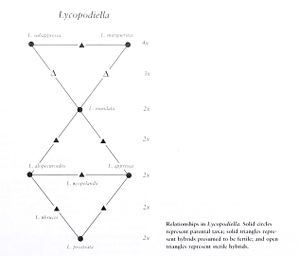Difference between revisions of "Lycopodiella"
Preslia 36: 20, 22. 1964.
FNA>Volume Importer |
FNA>Volume Importer |
||
| Line 18: | Line 18: | ||
}}<!-- | }}<!-- | ||
| − | --><span class="statement" id="st- | + | --><span class="statement" id="st-undefined" data-properties=""><b>Plants </b>creeping on wet ground. <b>Roots</b> emerging immediately on underside of stems. <b>Horizontal</b> stems on substrate surface, supine or arching. <b>Upright</b> shoots forming very leafy peduncles scattered along horizontal stems, 2–9 mm diam., unbranched. <b>Gemmiferous</b> branchlets and gemmae absent. <b>Strobili</b> solitary, fully differentiated from peduncle or peduncle not differentiated, tip blunt to ± acute; peduncle leafy, leaves not in distinct ranks, not imbricate, usually monomorphic, linear-lanceolate, margins commonly with a few teeth; sporophylls generally longer than peduncle leaves. <b>Sporangia</b> nearly globose. <b>Spores</b> rugulate, sides at equator convex, angles acute. <b>Gametophytes</b> photosynthetic, on substrate surface, pincushion-shaped; ring meristem absent. <b>x</b> = 78.</span><!-- |
-->{{Treatment/Body | -->{{Treatment/Body | ||
| Line 99: | Line 99: | ||
|publication year=1964 | |publication year=1964 | ||
|special status= | |special status= | ||
| − | |source xml=https://jpend@bitbucket.org/aafc-mbb/fna- | + | |source xml=https://jpend@bitbucket.org/aafc-mbb/fna-data-curation.git/src/9216fc802291cd3df363fd52122300479582ede7/coarse_grained_fna_xml/V2/V2_764.xml |
|genus=Lycopodiella | |genus=Lycopodiella | ||
| − | |||
| − | |||
| − | |||
| − | |||
| − | |||
| − | |||
| − | |||
| − | |||
| − | |||
| − | |||
| − | |||
| − | |||
| − | |||
| − | |||
| − | |||
| − | |||
| − | |||
| − | |||
| − | |||
| − | |||
| − | |||
| − | |||
| − | |||
| − | |||
| − | |||
| − | |||
| − | |||
| − | |||
| − | |||
| − | |||
| − | |||
}}<!-- | }}<!-- | ||
-->[[Category:Treatment]][[Category:Lycopodiaceae]] | -->[[Category:Treatment]][[Category:Lycopodiaceae]] | ||
Revision as of 14:27, 27 July 2019
Plants creeping on wet ground. Roots emerging immediately on underside of stems. Horizontal stems on substrate surface, supine or arching. Upright shoots forming very leafy peduncles scattered along horizontal stems, 2–9 mm diam., unbranched. Gemmiferous branchlets and gemmae absent. Strobili solitary, fully differentiated from peduncle or peduncle not differentiated, tip blunt to ± acute; peduncle leafy, leaves not in distinct ranks, not imbricate, usually monomorphic, linear-lanceolate, margins commonly with a few teeth; sporophylls generally longer than peduncle leaves. Sporangia nearly globose. Spores rugulate, sides at equator convex, angles acute. Gametophytes photosynthetic, on substrate surface, pincushion-shaped; ring meristem absent. x = 78.
Distribution
North temperate region and tropical America.
Discussion
This concept of Lycopodiella excludes the segregate genera Pseudolycopodiella (including Lycopodium carolinianum) and Palhinhaea (including Lycopodium cernuum). It has been treated as Lepidotis Palisot de Beauvois ex Mirbel, but this is a later name for Lycopodium. Species of Lycopodiella hybridize readily (see reticulogram). Hybrids between species of the same ploidy level are apparently fertile with normal meiosis and spores, but those between different ploidy levels are sterile (J. G. Bruce 1975).
Species 8–10 (6 in the flora).
Selected References
Lower Taxa
Key
| 1 | Fertile shoots mostly 3.5–6 cm; sporophylls spreading; mainly north of 45º N latitude and high in mountains southward. | Lycopodiella inundata |
| 1 | Fertile shoots 4–45 cm but mostly 8–35 cm; sporophylls spreading or appressed; mainly south of 45° N latitude at low elevations. | > 2 |
| 2 | Strobili 0–2 mm thicker than upright shoot; horizontal stem leaves with marginal teeth absent or sparse. | > 3 |
| 2 | Strobili 3–6 mm thicker than upright shoot; horizontal stem leaves commonly with marginal teeth. | > 4 |
| 3 | Upright shoots 15–40 × 0.3–0.4 cm; horizontal stem leaves with scattered marginal teeth. | Lycopodiella appressa |
| 3 | Upright shoots 9–15 × 0.4–0.7 cm; horizontal stem leaves usually without marginal teeth. | Lycopodiella subappressa |
| 4 | Horizontal stems (excluding leaves) 2–4 mm diam., strongly arching above substrate, largest leaves 0.5–0.7 mm wide. | Lycopodiella alopecuroides |
| 4 | Horizontal stems (excluding leaves) 1.3–2.2 mm diam., prostrate, largest leaves 0.8–1.8 mm wide. | > 5 |
| 5 | Upright shoots 18–35 cm; horizontal stems 1.3–1.6 mm diam.; strobili 15–20 mm wide, with incurved, spreading leaves; sporophyll margins with 1–5 teeth. | Lycopodiella prostrata |
| 5 | Upright shoots 13–17 cm; horizontal stems 1.8–2.2 mm diam.; strobili 4–9 mm wide with incurved, ascending leaves; sporophyll margins lacking obvious teeth. | Lycopodiella margueritae |
